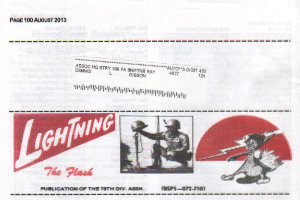 A ten-year-old blog post recently appeared in this site’s traffic statistics. The post told about the last issue of a publication devoted to a veteran’s organization to which my father had belonged. It isn’t terribly unusual for ten-year-old posts to get hits but I really can’t remember the last time this particular post appeared. The hit prompted me to reread the post and even update it a little. In the process, I was also prompted to let my thoughts wander down several of the many paths uncovered by my reading. Whoever clicked on the search result that took them to this old post missed Veterans/Armistice Day by a couple of weeks and this post misses it by even more but my mind — and maybe yours too — is still in a slightly reflective mood. So this week’s post consists of just this paragraph and a link to that ten-year-old post. Reflect as much or as little as pleases you: One Last Flash
A ten-year-old blog post recently appeared in this site’s traffic statistics. The post told about the last issue of a publication devoted to a veteran’s organization to which my father had belonged. It isn’t terribly unusual for ten-year-old posts to get hits but I really can’t remember the last time this particular post appeared. The hit prompted me to reread the post and even update it a little. In the process, I was also prompted to let my thoughts wander down several of the many paths uncovered by my reading. Whoever clicked on the search result that took them to this old post missed Veterans/Armistice Day by a couple of weeks and this post misses it by even more but my mind — and maybe yours too — is still in a slightly reflective mood. So this week’s post consists of just this paragraph and a link to that ten-year-old post. Reflect as much or as little as pleases you: One Last Flash
Author Archives: Denny
TG ’23
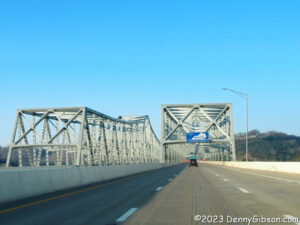 At one time, possibilities for Thanksgiving dinner included an Indiana state lodge with an overnight stay and an Ohio state lodge without. I dithered just a little too long, however, and both were completely filled before I made my calls. So I hastily put together a Plan C which involved an overnight stay in a Kentucky state lodge. That ‘C’ could stand for “cave” or “Carter” or both. Carter Caves State Resort Park was my destination as I crossed the Ohio River.
At one time, possibilities for Thanksgiving dinner included an Indiana state lodge with an overnight stay and an Ohio state lodge without. I dithered just a little too long, however, and both were completely filled before I made my calls. So I hastily put together a Plan C which involved an overnight stay in a Kentucky state lodge. That ‘C’ could stand for “cave” or “Carter” or both. Carter Caves State Resort Park was my destination as I crossed the Ohio River.
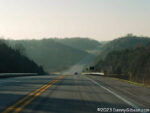
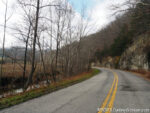
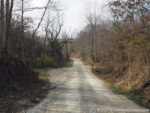 Most of the miles I drove in Kentucky were on KY‑9 which roughly parallels the Ohio River although it is usually at some distance. It’s a pretty nice-looking drive but the low morning sun and the mostly eastern bearing were no help at all in photographing the scenery. After just under a hundred miles of KY-9, Garmin had me turn south on KY-2 where the sun was less intrusive and the scenery possibly even better as the road ran along Buffalo Creek. After a few miles of KY-2, the GPS directed me onto KY-7 and then, barely a mile later, onto Sutton Road. Sutton Road soon became gravel. With my destination just a few miles away, I saw no reason for concern…
Most of the miles I drove in Kentucky were on KY‑9 which roughly parallels the Ohio River although it is usually at some distance. It’s a pretty nice-looking drive but the low morning sun and the mostly eastern bearing were no help at all in photographing the scenery. After just under a hundred miles of KY-9, Garmin had me turn south on KY-2 where the sun was less intrusive and the scenery possibly even better as the road ran along Buffalo Creek. After a few miles of KY-2, the GPS directed me onto KY-7 and then, barely a mile later, onto Sutton Road. Sutton Road soon became gravel. With my destination just a few miles away, I saw no reason for concern…
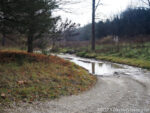
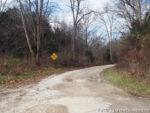 …until I reached a T. The road to the right was marked with a “DEAD END” sign. To the left was a low water bridge with not much that I could see beyond it. Garmin assured me that Carter Caves Park was just a few minutes away on the other side. While I contemplated the situation, I checked the GPS to see if it was really in “Faster” mode and not in “Shorter” or “Adventurous” mode. It was. I have gone straight ahead in similar situations in the past but on this day I wasn’t in adventurous mode either. After turning around and traveling a short distance, I could look back and see a road heading off on the other side of the stream. I was tempted but continued on the prudent path.
…until I reached a T. The road to the right was marked with a “DEAD END” sign. To the left was a low water bridge with not much that I could see beyond it. Garmin assured me that Carter Caves Park was just a few minutes away on the other side. While I contemplated the situation, I checked the GPS to see if it was really in “Faster” mode and not in “Shorter” or “Adventurous” mode. It was. I have gone straight ahead in similar situations in the past but on this day I wasn’t in adventurous mode either. After turning around and traveling a short distance, I could look back and see a road heading off on the other side of the stream. I was tempted but continued on the prudent path.
 I entered the park about half an hour later after a drive of 20, rather than 2, miles. Even so, I was there way ahead of my scheduled dinner time and assumed it was also too early to check in. I explored the park in my car and found every possible parking spot near the lodge/restaurant filled. The feeding frenzy was in full swing. There was a reasonable mix of cars and open spaces at the visitor center so I pulled in to take a look.
I entered the park about half an hour later after a drive of 20, rather than 2, miles. Even so, I was there way ahead of my scheduled dinner time and assumed it was also too early to check in. I explored the park in my car and found every possible parking spot near the lodge/restaurant filled. The feeding frenzy was in full swing. There was a reasonable mix of cars and open spaces at the visitor center so I pulled in to take a look.

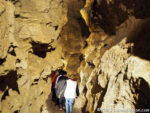
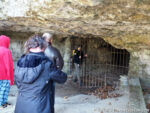 Once inside, I was pleasantly surprised to find that cave tours were taking place that day and even more pleasantly surprised to learn that a tour of X‑Cave was starting in just five minutes. X‑Cave is not very large but it does have a lot of interesting formations. It gets its name from two passageways that intersect to form an ‘X’. Tours travel through one side of the ‘X’, step outside, reenter, and travel through the other side. On the first pass through the intersection, the tour guide shared the cave’s very own Daniel Boone story. It’s extra appropriate on Thanksgiving Day.
Once inside, I was pleasantly surprised to find that cave tours were taking place that day and even more pleasantly surprised to learn that a tour of X‑Cave was starting in just five minutes. X‑Cave is not very large but it does have a lot of interesting formations. It gets its name from two passageways that intersect to form an ‘X’. Tours travel through one side of the ‘X’, step outside, reenter, and travel through the other side. On the first pass through the intersection, the tour guide shared the cave’s very own Daniel Boone story. It’s extra appropriate on Thanksgiving Day.
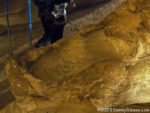
 While hunting one day, Boone spotted the largest turkey he had ever seen. He inexplicably missed his first shot but saw the turkey enter the cave He hurriedly lit a torch and followed. Reaching the underground intersection, Boone saw the turkey down one of the passageways and fired. In his haste and weak light, the frontiersman had overloaded his rifle with powder and the blast threw him backward with such force that the imprint of his foot can still be seen. The turkey was missed once again by the shot but was so badly frightened that it instantly turned to stone.
While hunting one day, Boone spotted the largest turkey he had ever seen. He inexplicably missed his first shot but saw the turkey enter the cave He hurriedly lit a torch and followed. Reaching the underground intersection, Boone saw the turkey down one of the passageways and fired. In his haste and weak light, the frontiersman had overloaded his rifle with powder and the blast threw him backward with such force that the imprint of his foot can still be seen. The turkey was missed once again by the shot but was so badly frightened that it instantly turned to stone.
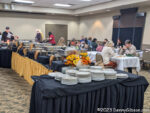
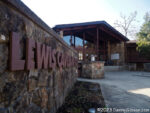 Things were still busy at the lodge but I was now able to find a parking spot. I was even able to check into my room where I relaxed until dinner time. There is a salad bar behind me and a dessert-filled table just beyond the ham carving station. I helped myself to turkey and stuffing and more but decided against the ham when I reached it. I think that was because I had also helped myself to that other traditional Thanksgiving entree, catfish, when I filled my plate. After dinner, as I again relaxed in my room, I decided to get on board with the popular Elf on a Shelf craze.
Things were still busy at the lodge but I was now able to find a parking spot. I was even able to check into my room where I relaxed until dinner time. There is a salad bar behind me and a dessert-filled table just beyond the ham carving station. I helped myself to turkey and stuffing and more but decided against the ham when I reached it. I think that was because I had also helped myself to that other traditional Thanksgiving entree, catfish, when I filled my plate. After dinner, as I again relaxed in my room, I decided to get on board with the popular Elf on a Shelf craze.
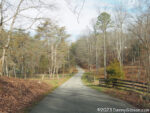
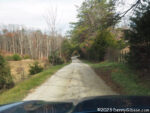
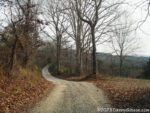 When I left the lodge on Friday, I was only slightly surprised when the GPS directed me to turn left rather than retrace the way I’d arrived. Even though the road name didn’t register immediately, it did eventually, and as Sutton Road became narrower and more gravely, I knew exactly where Garmin was leading me.
When I left the lodge on Friday, I was only slightly surprised when the GPS directed me to turn left rather than retrace the way I’d arrived. Even though the road name didn’t register immediately, it did eventually, and as Sutton Road became narrower and more gravely, I knew exactly where Garmin was leading me.
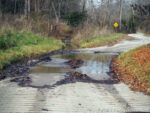
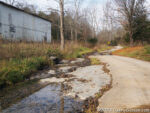
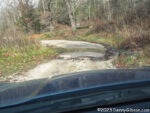 This is the other side of that low-water bridge where I turned around Thursday. On Friday, having seen both sides, I had no qualms about splashing right on through. In fact, I was quite happy to do so and erase some of the guilt I felt about not splashing through the day before.
This is the other side of that low-water bridge where I turned around Thursday. On Friday, having seen both sides, I had no qualms about splashing right on through. In fact, I was quite happy to do so and erase some of the guilt I felt about not splashing through the day before.
A Mighty Fine Season
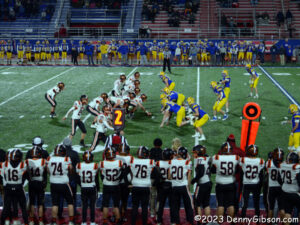 The 2023 Ansonia High School football team suffered its first loss of the year on Friday. It will be their only loss as it ended their run at the state championship after a 10-0 regular season and 3 playoff victories. The game was at the same stadium in Piqua as last week’s game, and the afternoon rain had moved out by game time so Terry and I did make it. This week, though, we were the lower seed and sat on the visitor’s side of the field.
The 2023 Ansonia High School football team suffered its first loss of the year on Friday. It will be their only loss as it ended their run at the state championship after a 10-0 regular season and 3 playoff victories. The game was at the same stadium in Piqua as last week’s game, and the afternoon rain had moved out by game time so Terry and I did make it. This week, though, we were the lower seed and sat on the visitor’s side of the field.
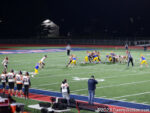
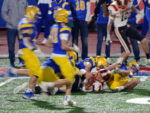
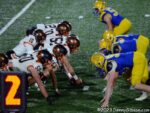 The Tigers got the ball first, and their running game ate up a lot of ground and time but ultimately came up a little short of the end zone.
The Tigers got the ball first, and their running game ate up a lot of ground and time but ultimately came up a little short of the end zone.
 Ansonia remained very much in the game through the first half. They never managed to score themselves but held the Marion Local Flyers to a single touchdown that was scored on a passing play. When the half ended, that touchdown and point after were all that separated the two teams score-wise.
Ansonia remained very much in the game through the first half. They never managed to score themselves but held the Marion Local Flyers to a single touchdown that was scored on a passing play. When the half ended, that touchdown and point after were all that separated the two teams score-wise.


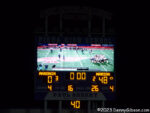 The second half was a different story. The Tigers came out ready to play but so did the Flyers who scored in less than a minute on their first possession. The experience and size of the Marion Local team combined with some tiredness and demoralization on the other side to put the game out of reach fairly quickly. The Tigers were outplayed in this game but oh boy what a season! The 13 wins are the most ever for the school. They are nearly double the total number of wins during my entire time as a student (0-9, 0-9, 4-5, 3-6). Coincidentally, one of those four wins in 1963 was against Marion Local. The post title has it right. 13-1 makes for a mighty fine season.
The second half was a different story. The Tigers came out ready to play but so did the Flyers who scored in less than a minute on their first possession. The experience and size of the Marion Local team combined with some tiredness and demoralization on the other side to put the game out of reach fairly quickly. The Tigers were outplayed in this game but oh boy what a season! The 13 wins are the most ever for the school. They are nearly double the total number of wins during my entire time as a student (0-9, 0-9, 4-5, 3-6). Coincidentally, one of those four wins in 1963 was against Marion Local. The post title has it right. 13-1 makes for a mighty fine season.
ADDENDUM 2-Dec-2023: Today Marion Local won the Division VII State Championship by defeating Dalton, 38-0. This extended their unbeaten streak to 48 and their consecutive state championship streak to 3. We were beaten by the best.
Coffee With Jim (Hinckley)
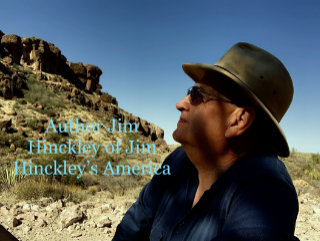 I’m scheduled to be on Coffee With Jim, a podcast from Jim Hinkley’s America, this week. I know that some, but I’m sure not all, of our conversation will be about “Tracing a T to Tampa”. It will be recorded at 9:00 AM EST Sunday, November 19, and clicking here should allow you to listen in if you so desire. I believe that commenting or asking questions requires the PodBean app which is available on the page.
I’m scheduled to be on Coffee With Jim, a podcast from Jim Hinkley’s America, this week. I know that some, but I’m sure not all, of our conversation will be about “Tracing a T to Tampa”. It will be recorded at 9:00 AM EST Sunday, November 19, and clicking here should allow you to listen in if you so desire. I believe that commenting or asking questions requires the PodBean app which is available on the page.
The program will be published on Spotify and other major podcast sources within a few hours of being recorded. If you don’t already have a favorite player and subscription service, it can be heard, once published, via the embedded player on Jim Hinkley’s America home page. You’ll have to scroll down just a bit.
A Win for Ansonia
 Until last Friday, I don’t believe I had attended a single football game played by my high school alma mater since I graduated. Furthermore, it seems quite likely that I had not attended a game as a spectator ever. I had attended every game in the four years prior to graduation but it was always as a member of the marching band. Friday night was a new experience for me in several ways not the least of which was the favorable final score.
Until last Friday, I don’t believe I had attended a single football game played by my high school alma mater since I graduated. Furthermore, it seems quite likely that I had not attended a game as a spectator ever. I had attended every game in the four years prior to graduation but it was always as a member of the marching band. Friday night was a new experience for me in several ways not the least of which was the favorable final score.
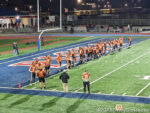 Of course, I’d thought about attending a game on several occasions but never followed through. I probably would not have made it to Friday’s game if my friend Terry had not been paying more attention to things than I was. Although our friendship goes back even further than high school, we did not attend the same school. Terry’s son did attend Ansonia High School and played on successful teams there in the 1980s.
Of course, I’d thought about attending a game on several occasions but never followed through. I probably would not have made it to Friday’s game if my friend Terry had not been paying more attention to things than I was. Although our friendship goes back even further than high school, we did not attend the same school. Terry’s son did attend Ansonia High School and played on successful teams there in the 1980s.
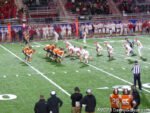 As the regular season ended, it was Terry who made me aware of Ansonia’s 10-0 record and their entry into the 2023 playoffs. As the #2 seed for Division VII, their first two playoff games were on their home field but I was, unfortunately, out of town for both. Fortunately, they won them both (52-7, 34-8) to set up Friday’s match with St Henry at a neutral site. Also on the fortunate side of things, I was home for this one.
As the regular season ended, it was Terry who made me aware of Ansonia’s 10-0 record and their entry into the 2023 playoffs. As the #2 seed for Division VII, their first two playoff games were on their home field but I was, unfortunately, out of town for both. Fortunately, they won them both (52-7, 34-8) to set up Friday’s match with St Henry at a neutral site. Also on the fortunate side of things, I was home for this one.
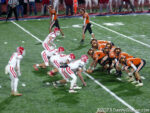

 The game was a good one. Ansonia never trailed but our victory was not assured until the closing moments. With no kicking and little passing, the Tigers repeatedly moved the chains on third and fourth down with what often seemed like just inches to spare. The officials thought only one of their two-point conversion attempts was successful although there was serious disagreement from AHS fans on one of the others. Ansonia will play #1 seed Marion Local next Friday but where has not been determined. Whether or not Terry and I are there will depend a lot on the location.
The game was a good one. Ansonia never trailed but our victory was not assured until the closing moments. With no kicking and little passing, the Tigers repeatedly moved the chains on third and fourth down with what often seemed like just inches to spare. The officials thought only one of their two-point conversion attempts was successful although there was serious disagreement from AHS fans on one of the others. Ansonia will play #1 seed Marion Local next Friday but where has not been determined. Whether or not Terry and I are there will depend a lot on the location.
ADDENDUM 19-Nov-2023: The Marion Local game was also at the Piqua stadium, and we did attend. Read about it here.
![]() As implied by this headline from my days as a student, rooting for a winning team was once an impossible dream. The thirty-eight-game streak it refers to came to an end just a little over sixty years ago on September 13, 1963.
As implied by this headline from my days as a student, rooting for a winning team was once an impossible dream. The thirty-eight-game streak it refers to came to an end just a little over sixty years ago on September 13, 1963.
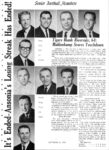
 Both of these images are from the 1964 Ansonia High School yearbook. The first contains photos of the seniors on the team that ended the streak along with a local newspaper report of the event which attracted some national attention as well. The second image shows the entire team. In those days, yearbooks, at least those for small Ohio schools, were entirely black and white with the exception of the endpapers. There could be no better use of the book’s only splash of color than recognizing the group that ended what I believe was the longest losing streak in the nation at the time.
Both of these images are from the 1964 Ansonia High School yearbook. The first contains photos of the seniors on the team that ended the streak along with a local newspaper report of the event which attracted some national attention as well. The second image shows the entire team. In those days, yearbooks, at least those for small Ohio schools, were entirely black and white with the exception of the endpapers. There could be no better use of the book’s only splash of color than recognizing the group that ended what I believe was the longest losing streak in the nation at the time.
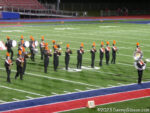 I mentioned that my previous AHS football game attendance involved the school band. The band’s fortunes over the last six decades do not appear to match those of the team. The picture at right shows the band during halftime of Friday’s game. I counted about twenty members, and Terry said that was noticeably more than what he remembered from the last game he attended.
I mentioned that my previous AHS football game attendance involved the school band. The band’s fortunes over the last six decades do not appear to match those of the team. The picture at right shows the band during halftime of Friday’s game. I counted about twenty members, and Terry said that was noticeably more than what he remembered from the last game he attended.
![]() There were 54 in the band that would have marched at that big 1963 win.
There were 54 in the band that would have marched at that big 1963 win.
Trip Peek #128
Trip #118
LHA Conference 2014
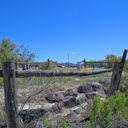 This picture is from my 2014 Lincoln Highway Conference trip. The conference was in Tooele, Utah, and the picture is of the wooden Lincoln Highway bridge inside the Dugway Proving Grounds. We visited the “off-limits” area as part of a bus tour. On the way to the conference, I made an effort to reach new-to-me sections of the LH including the Colorado Loop and the route through Elk Mountain, WY, which ultimately lost out to the Medicine Bow route. Both of those involved a lot of unpaved roadway. I spent a night (and had a fabulous dinner) at the Elk Mountain Hotel and another at the Historic Plains Hotel in Cheyenne. The bus tour that took us to Dugway was supposed to include a visit to the Goodyear Cutoff but, despite advance scheduling, it was scuttled by bombing practice. We did get to Orr’s Ranch and Willow Springs Ranch and a second bus tour took us to Ogden and other points east of Tooele.
This picture is from my 2014 Lincoln Highway Conference trip. The conference was in Tooele, Utah, and the picture is of the wooden Lincoln Highway bridge inside the Dugway Proving Grounds. We visited the “off-limits” area as part of a bus tour. On the way to the conference, I made an effort to reach new-to-me sections of the LH including the Colorado Loop and the route through Elk Mountain, WY, which ultimately lost out to the Medicine Bow route. Both of those involved a lot of unpaved roadway. I spent a night (and had a fabulous dinner) at the Elk Mountain Hotel and another at the Historic Plains Hotel in Cheyenne. The bus tour that took us to Dugway was supposed to include a visit to the Goodyear Cutoff but, despite advance scheduling, it was scuttled by bombing practice. We did get to Orr’s Ranch and Willow Springs Ranch and a second bus tour took us to Ogden and other points east of Tooele.
Getting home was every bit as much fun as getting there or being there. I headed north and made stops at the Golden Spike National Historic Site and the Spiral Jetty before clipping the southeast corner of Idaho. From there to Cincinnati, my stops read like an All-American travel brochure: Grand Teton, Yellowstone, Little Bighorn, Devil’s Tower, Crazy Horse, Mount Rushmore, Wall Drug, Badlands, Corn Palace, Jolly Green Giant, Spam Museum, and Field of Dreams.
Trip Peeks are short articles published when my world is too busy or too boring for a current events piece to be completed in time for the Sunday posting. In addition to a photo thumbnail from a completed road trip, each Peek includes a brief description of that photo plus links to the full-sized photo and the associated trip journal.
Trip Peek #127
Trip #46
Smoky Thanksgiving
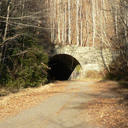 This picture is from my 2006 A Smoky Thanksgiving trip. It was my second year running away from home for Thanksgiving and I picked the Great Smoky Mountains for my escape. The photo is of the tunnel on a road promised but never completed. The road was to provide access to cemeteries isolated by the creation of Lake Fontana but the shamefully broken promise only created this “road to nowhere”. Besides a walk through the tunnel, the trip included driving some Dixie Highway and the Cherohala Skyway, riding the Great Smoky Mountains Railroad, and doing some sightseeing with Baby Boomer Bob as guide.
This picture is from my 2006 A Smoky Thanksgiving trip. It was my second year running away from home for Thanksgiving and I picked the Great Smoky Mountains for my escape. The photo is of the tunnel on a road promised but never completed. The road was to provide access to cemeteries isolated by the creation of Lake Fontana but the shamefully broken promise only created this “road to nowhere”. Besides a walk through the tunnel, the trip included driving some Dixie Highway and the Cherohala Skyway, riding the Great Smoky Mountains Railroad, and doing some sightseeing with Baby Boomer Bob as guide.
Trip Peeks are short articles published when my world is too busy or too boring for a current events piece to be completed in time for the Sunday posting. In addition to a photo thumbnail from a completed road trip, each Peek includes a brief description of that photo plus links to the full-sized photo and the associated trip journal.
Tracing a T to Sebring
 I have written several times of being surprised to learn that my great-grandparents drove a Model T Ford to Florida and back in 1920. That surprise came many years ago and since then I have twice retraced their trip and wrote a book about the retracing. Letters my great-grandmother sent her daughter allowed me to follow their general path. A cousin and I dug into those letters as I prepared for the second retracing and were again surprised when we realized there were letters from a second Florida trip mixed in with them. There was great joy in that surprise along with a little disappointment. Unlike the 1920 letters, those from the second trip in 1923 did not document the entire adventure but trailed off mid-sentence shortly after the travelers reached the vicinity of Sebring, FL.
I have written several times of being surprised to learn that my great-grandparents drove a Model T Ford to Florida and back in 1920. That surprise came many years ago and since then I have twice retraced their trip and wrote a book about the retracing. Letters my great-grandmother sent her daughter allowed me to follow their general path. A cousin and I dug into those letters as I prepared for the second retracing and were again surprised when we realized there were letters from a second Florida trip mixed in with them. There was great joy in that surprise along with a little disappointment. Unlike the 1920 letters, those from the second trip in 1923 did not document the entire adventure but trailed off mid-sentence shortly after the travelers reached the vicinity of Sebring, FL.
Of course, half a trip is better than no trip, and I’ve used those letters from 1923 to produce the route I’m now following. Granddad and Granny started their journey on October 29, 1923, and my original plan was to start my retrace exactly one hundred years later. But time constraints on the tail end of the outing have prompted me to set out just a few days early in hopes of making things a little more relaxed. At some point, I will be exactly where they were a century ago. There is no guarantee I’ll be able to sort out just where and when that is, though, but I do intend to try.
This entry lets blog-only subscribers know about the trip and provides a place for comments. The journal is here.
Trip Peek #126
Trip #163
PA Cars
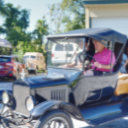 This picture is from my 2021 PA Cars trip. PA, or Pennsylvania, is where I went and cars is what I went for. The first big car exposure was in Allentown, PA, where my friend Dave Reese gave me another personal tour of the America on Wheels museum. From Allentown, my farthest point east, I headed west to Hershey and the AACA Museum. The trip was more or less organized around the museum’s Model T Driving Experience and that’s what the photo is from. Of course, I worked in a stroll through all of the AACA exhibits and a stop at The Hershey Story Museum too. I got in some miles on both the Lincoln Highway and the National Road and enjoyed a night of historic lodging on each. The National Road miles were eastbound and I spent the first night of the trip at the Headley Inn near Zanesville, OH. The last night of the trip was spent at the Lincoln Motor Court beside the Lincoln Highway near Bedford, PA.
This picture is from my 2021 PA Cars trip. PA, or Pennsylvania, is where I went and cars is what I went for. The first big car exposure was in Allentown, PA, where my friend Dave Reese gave me another personal tour of the America on Wheels museum. From Allentown, my farthest point east, I headed west to Hershey and the AACA Museum. The trip was more or less organized around the museum’s Model T Driving Experience and that’s what the photo is from. Of course, I worked in a stroll through all of the AACA exhibits and a stop at The Hershey Story Museum too. I got in some miles on both the Lincoln Highway and the National Road and enjoyed a night of historic lodging on each. The National Road miles were eastbound and I spent the first night of the trip at the Headley Inn near Zanesville, OH. The last night of the trip was spent at the Lincoln Motor Court beside the Lincoln Highway near Bedford, PA.
Trip Peeks are short articles published when my world is too busy or too boring for a current events piece to be completed in time for the Sunday posting. In addition to a photo thumbnail from a completed road trip, each Peek includes a brief description of that photo plus links to the full-sized photo and the associated trip journal.
Route 66 Miles of Possibility 2023
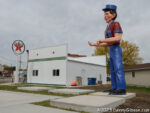 As my schedule got increasingly messy, I let this event slide out of consideration. It again caught my eye when organizers announced an extension of the early-bird cut off and I realized that I could fit it in. So I’m off to the only annual conference dedicated to Historic Route 66. This is the eighth year for the conference, my fourth time attending, and the first time I’ve made it to two in a row. The conference actually starts Thursday morning but there was an associated concert on Wednesday and I planned the staging drive to include a major new attraction on the route. The first day of the journal is now in place.
As my schedule got increasingly messy, I let this event slide out of consideration. It again caught my eye when organizers announced an extension of the early-bird cut off and I realized that I could fit it in. So I’m off to the only annual conference dedicated to Historic Route 66. This is the eighth year for the conference, my fourth time attending, and the first time I’ve made it to two in a row. The conference actually starts Thursday morning but there was an associated concert on Wednesday and I planned the staging drive to include a major new attraction on the route. The first day of the journal is now in place.
This entry lets blog-only subscribers know about the trip and provides a place for comments. The journal is here.
